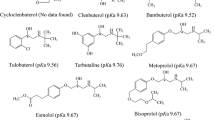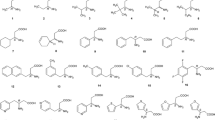Abstract
We report a chiral high-performance liquid chromatographic enantioseparation method for free α-aminophosphonic, β-aminophosphonic, and γ-aminophosphonic acids, aminohydroxyphosphonic acids, and aromatic aminophosphinic acids with different substitution patterns. Enantioseparation of these synthons was achieved by means of high-performance liquid chromatography on CHIRALPAK ZWIX(+) and ZWIX(-) (cinchona-based chiral zwitterionic ion exchangers) under polar organic chromatographic elution conditions. Mobile phase characteristics such as acid-to-base ratio, type of counterion, and solvent composition were systematically varied in order to investigate their effect on the separation performance and to achieve optimal separation conditions for the set of analytes. Under the optimized conditions, 32 of 37 racemic aminophosphonic acids studied reached baseline separation when we employed a single generic mass-spectrometry-compatible mobile phase, with reversal of the elution order when we used (+) and (-) versions of the chiral stationary phase.

New zwitterionic ion-exchangers can separate free amino phosphonic acids and a change from Chiralpak ZWIX(+) to ZWIX(-) allows reversal of enantiomer elution order









Similar content being viewed by others
References
Hudson HR, Kukhar VP (2000) Aminophosphonic and aminophosphinic acids: chemistry and biological activity. Wiley, New York
Mucha A, Kafarski P, Berlicki L (2011) Remarkable potential of the alpha-aminophosphonate/phosphinate structural motif in medicinal chemistry. J Med Chem 54(17):5955–5980. doi:10.1021/jm200587f
Morphy JR, Beeley NRA, Boyce BA, Leonard J, Mason B, Millican A, Millar K, Oconnell JP, Porter J (1994) Potent and selective inhibitors of gelatinase-A. 2. Carboxylic and phosphonic acid-derivatives. Bioorg Med Chem Lett 4(23):2747–2752. doi:10.1016/S0960-894x(01)80588-6
Kraicheva I, Bogomilova A, Tsacheva I, Momekov G, Troev K (2009) Synthesis, NMR characterization and in vitro antitumor evaluation of new aminophosphonic acid diesters. Eur J Med Chem 44(8):3363–3367. doi:10.1016/j.ejmech.2009.03.017
Kafarski P, Lejczak B (1991) Biological activity of aminophosphonic acids. Phosphorus Sulfur 63(1–2):193–215. doi:10.1080/10426509108029443
Grzywa R, Oleksyszyn J, Salvesen GS, Drag M (2010) Identification of very potent inhibitor of human aminopeptidase N (CD13). Bioorg Med Chem Lett 20(8):2497–2499. doi:10.1016/j.bmcl.2010.02.111
Selvam C, Goudet C, Oueslati N, Pin JP, Acher FC (2007) L-(+)-2-Amino-4-thiophosphonobutyric acid (L-thioAP4), a new potent agonist of group III metabotropic glutamate receptors: increased distal acidity affords enhanced potency. J Med Chem 50(19):4656–4664. doi:10.1021/jm070400y
Wallace EM, Moliterni JA, Moskal MA, Neubert AD, Marcopulos N, Stamford LB, Trapani AJ, Savage P, Chou M, Jeng AY (1998) Design and synthesis of potent, selective inhibitors of endothelin-converting enzyme. J Med Chem 41(9):1513–1523. doi:10.1021/jm970787c
Beck J, Gharbi S, Herteg-Fernea A, Vercheval L, Bebrone C, Lassaux P, Zervosen A, Marchand-Brynaert J (2009) Aminophosphonic acids and aminobis(phosphonic acids) as potential inhibitors of penicillin-binding proteins. Eur J Org Chem 2009(1):85–97. doi:10.1002/ejoc.200800812
Yang S, Gao X-W, Diao C-L, Song B-A, Jin L-H, Xu G-F, Zhang G-P, Wang W, Hu D-Y, Xue W, Zhou X, Lu P (2006) Synthesis and antifungal activity of novel chiral α-aminophosphonates containing fluorine moiety. Chin J Chem 24(11):1581–1588. doi:10.1002/cjoc.200690296
Manning HC, Goebel T, Marx JN, Bornhop DJ (2002) Facile, efficient conjugation of a trifunctional lanthanide chelate to a peripheral benzodiazepine receptor ligand. Org Lett 4(7):1075–1078. doi:10.1021/ol017155b
Hammerschmidt F, Hanbauer M (2000) Transformation of arylmethylamines into alpha-aminophosphonic acids via metalated phosphoramidates: rearrangement of partly configurationally stable N-phosphorylated alpha-aminocarbanions. J Org Chem 65(19):6121–6131. doi:10.1021/jo000585f
Hammerschmidt F, Li Y-F (1994) Determination of absolute configuration of α-hydroxyphosphonates by 31P NMR spectroscopy of corresponding Mosher esters. Tetrahedron 50:10253–10264. doi:10.1016/s0040-4020(01)81758-0
Hammerschmidt F, Wuggenig F (1999) Enzymes in organic chemistry. Part 9: chemo-enzymatic synthesis of phosphonic acid analogues of L-valine, L-leucine, L-isoleucine, L-methionine and L-α-aminobutyric acid of high enantiomeric excess. Tetrahedron-Asymmetry 10:1709–1721. doi:10.1016/s0957-4166(99)00152-4
Schmidt U, Krause HW, Oehme G, Michalik M, Fischer C (1998) Enantioselective synthesis of α-aminophosphonic acid derivatives by hydrogenation. Chirality 10:564–572. doi:10.1002/(sici)1520-636x(1998)10:7<564::aid-chir3>3.0.co;2-2
Woschek A, Lindner W, Hammerschmidt F (2003) Enzymes in organic chemistry, 11:[1] hydrolase-catalyzed resolution of α- and β-hydroxyphosphonates and synthesis of chiral, non-racemic β-aminophosphonic acids. Adv Synth Catal 345(12):1287–1298. doi:10.1002/adsc.200303135
Wuggenig F, Schweifer A, Mereiter K, Hammerschmidt F (2011) Chemoenzymatic synthesis of phosphonic acid analogues of L-lysine, L-proline, L-ornithine, and L-pipecolic acid of 99 % ee – assignment of absolute configuration to (–)-proline. Eur J Org Chem 2011(10):1870–1879. doi:10.1002/ejoc.201001501
Hammerschmidt F, Voellenkle H (1989) Absolute configuration of (2-amino-1-hydroxyethyl) phosphonic acid from Acanthamoeba castellanii (Neff). Preparation of phosphonic acid analogs of (+)- and (-)-serine. Liebigs Ann Chem 1989(6):577–583. doi:10.1002/jlac.1989198901101
Fischer C, Schmidt U, Dwars T, Oehme G (1999) Enantiomeric resolution of derivatives of α-aminophosphonic and α-aminophosphinic acids by high-performance liquid chromatography and capillary electrophoresis. J Chromatogr A 845(1–2):273–283. doi:10.1016/s0021-9673(99)00487-2
Pirkle WH, Burke JA (1992) Separation of the enantiomers of the 3,5-dinitrobenzamide derivatives of α-amino phosphonates on four chiral stationary phases. J Chromatogr A 598(2):159–167. doi:10.1016/0021-9673(92)85044-T
Pirkle WH, Jonathan Brice L, Caccamese S, Principato G, Failla S (1996) Facile separation of the enantiomers of diethyl N-(aryl)-1-amino-1-arylmethanephosphonates on a rationally designed chiral stationary phase. J Chromatogr A 721(2):241–246. doi:10.1016/0021-9673(95)00844-6
Pirkle WH, Jonathan Brice L, Widlanski TS, Roestamadji J (1996) Resolution and determination of the enantiomeric purity and absolute configurations of α-aryl-α-hydroxymethanephosphonates. Tetrahedron-Asymmetry 7(8):2173–2176. doi:10.1016/0957-4166(96)00263-7
Zarbl E, Lammerhofer M, Hammerschmidt F, Wuggenig F, Hanbauer M, Maier NM, Sajovic L, Lindner W (2000) Direct liquid chromatographic enantioseparation of chiral alpha- and beta-aminophosphonic acids employing quinine-derived chiral anion exchangers: determination of enantiomeric excess and verification of absolute configuration. Anal Chim Acta 404(2):169–177. doi:10.1016/s0003-2670(99)00700-x
Lämmerhofer M, Hebenstreit D, Gavioli E, Lindner W, Mucha A, Kafarski P, Wieczorek P (2003) High-performance liquid chromatographic enantiomer separation and determination of absolute configurations of phosphinic acid analogues of dipeptides and their α-aminophosphinic acid precursors. Tetrahedron-Asymmetry 14(17):2557–2565. doi:10.1016/s0957-4166(03)00537-8
Hoffmann CV, Reischl R, Maier NM, Lämmerhofer M, Lindner W (2009) Stationary phase-related investigations of quinine-based zwitterionic chiral stationary phases operated in anion-, cation-, and zwitterion-exchange modes. J Chromatogr A 1216(7):1147–1156. doi:10.1016/j.chroma.2008.12.045
Hoffmann CV, Pell R, Lämmerhofer M, Lindner W (2008) Synergistic effects on enantioselectivity of zwitterionic chiral stationary phases for separations of chiral acids, bases, and amino acids by HPLC. Anal Chem 80(22):8780–8789. doi:10.1021/ac801384f
Hoffmann CV, Reischl R, Maier NM, Lämmerhofer M, Lindner W (2009) Investigations of mobile phase contributions to enantioselective anion- and zwitterion-exchange modes on quinine-based zwitterionic chiral stationary phases. J Chromatogr A 1216(7):1157–1166. doi:10.1016/j.chroma.2008.12.044
Pell R, Sić S, Lindner W (2012) Mechanistic investigations of cinchona alkaloid-based zwitterionic chiral stationary phases. J Chromatogr A. doi:10.1016/j.chroma.2012.08.006
Wernisch S, Lindner W (2012) Versatility of cinchona-based zwitterionic chiral stationary phases: enantiomer and diastereomer separations of non-protected oligopeptides utilizing a multi-modal chiral recognition mechanism. J Chromatogr A 1269:297–307. doi:10.1016/j.chroma.2012.06.094
Hoffmann CV, Reischl R, Maier NM, Lammerhofer M, Lindner W (2009) Investigations of mobile phase contributions to enantioselective anion- and zwitterion-exchange modes on quinine-based zwitterionic chiral stationary phases. J Chromatogr A 1216(7):1157–1166. doi:10.1016/j.chroma.2008.12.044
Hoffmann CV, Reischl R, Maier NM, Lammerhofer M, Lindner W (2009) Stationary phase-related investigations of quinine-based zwitterionic chiral stationary phases operated in anion-, cation-, and zwitterion-exchange modes. J Chromatogr A 1216(7):1147–1156. doi:10.1016/j.chroma.2008.12.045
Pell R, Sic S, Lindner W (2012) Mechanistic investigations of cinchona alkaloid-based zwitterionic chiral stationary phases. J Chromatogr A 1269:287–296. doi:10.1016/j.chroma.2012.08.006
Pell R, Sić S, Lindner W (2012) Mechanistic investigations of cinchona alkaloid-based zwitterionic chiral stationary phases. J Chromatogr A 1269:287–296. doi:10.1016/j.chroma.2012.08.006
Wernisch S, Pell R, Lindner W (2012) Increments to chiral recognition facilitating enantiomer separations of chiral acids, bases, and ampholytes using Cinchona-based zwitterion exchanger chiral stationary phases. J Sep Sci 35(13):1560–1572. doi:10.1002/jssc.201200103
Lämmerhofer M, Lindner W (1996) Quinine and quinidine derivatives as chiral selectors I. Brush type chiral stationary phases for high-performance liquid chromatography based on cinchonan carbamates and their application as chiral anion exchangers. J Chromatogr A 741(1):33–48. doi:10.1016/0021-9673(96)00137-9
Maier NM, Schefzick S, Lombardo GM, Feliz M, Rissanen K, Lindner W, Lipkowitz KB (2002) Elucidation of the chiral recognition mechanism of cinchona alkaloid carbamate-type receptors for 3,5-dinitrobenzoyl amino Acids. J Am Chem Soc 124(29):8611–8629. doi:10.1021/ja020203i
Acknowledgment
This work was financially supported by the University of Vienna through the interdisciplinary doctoral program Initiativkolleg Functional Molecules (IK I041−N). We thank Jan Pícha (Institute of Organic Chemistry and Biochemistry, AS CR) and Friedrich Hammerschmidt (Institute of Organic Chemistry, University of Vienna) for providing several samples of APAs. We are further grateful to the Operational Program Research and Development for Innovations - European Regional Development Fund (project CZ.1.05/2.1.00/03.0058) and the project of Palacký University in Olomouc PRF_2012_020 for financial support.
Author information
Authors and Affiliations
Corresponding authors
Additional information
Published in the topical collection Amino Acid Analysis with guest editor Toshimasa Toyo'oka.
Rights and permissions
About this article
Cite this article
Gargano, A.F.G., Kohout, M., Macíková, P. et al. Direct high-performance liquid chromatographic enantioseparation of free α-, β- and γ-aminophosphonic acids employing cinchona-based chiral zwitterionic ion exchangers. Anal Bioanal Chem 405, 8027–8038 (2013). https://doi.org/10.1007/s00216-013-6938-6
Received:
Revised:
Accepted:
Published:
Issue Date:
DOI: https://doi.org/10.1007/s00216-013-6938-6




